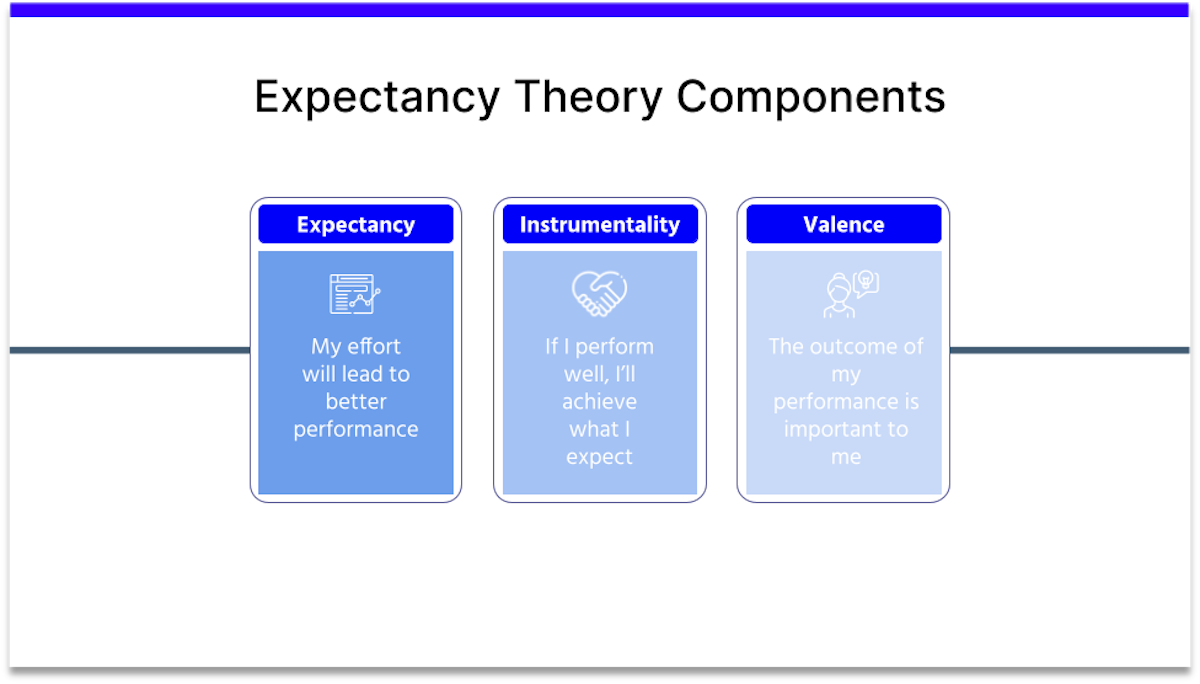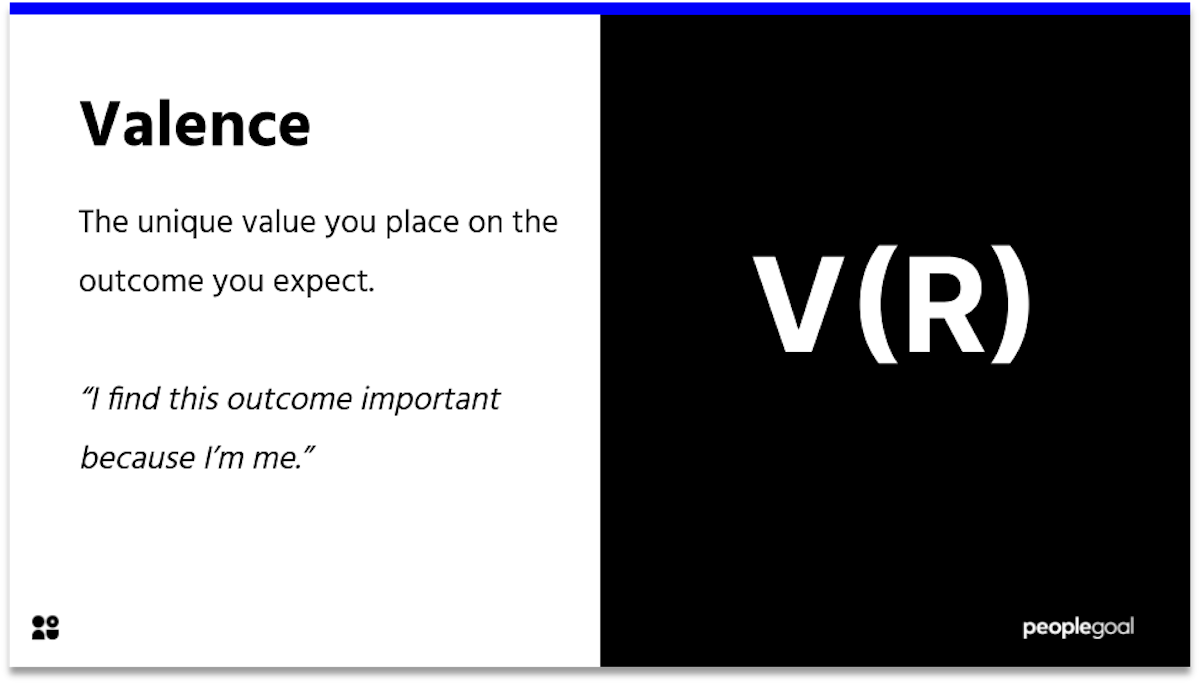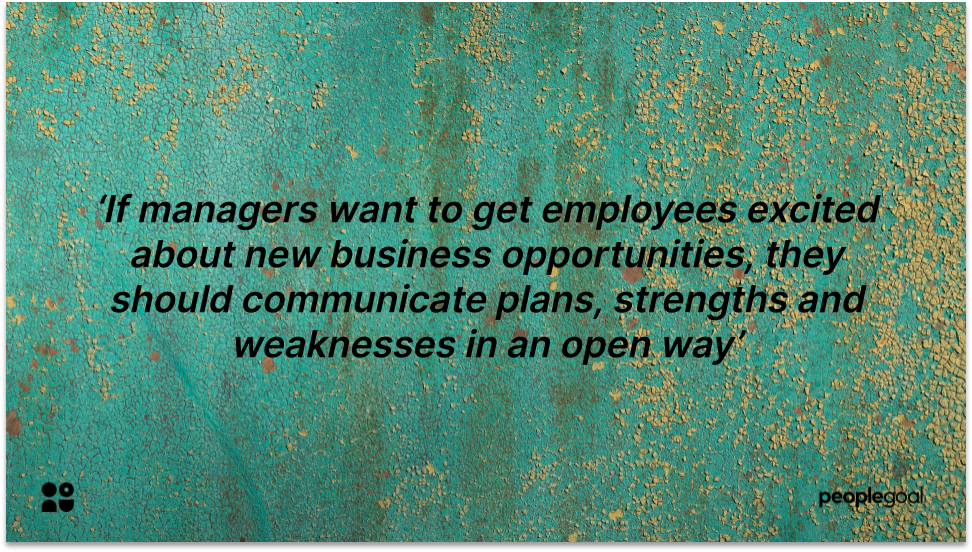Expectancy theory of motivation, developed by Victor Vroom of the Yale School of Management, describes the relationship between efforts, performance and outcomes. This motivational theory explains that an employee’s motivation is driven by how likely they think their effort will lead to the expected performance, their belief that this performance will lead to an outcome or reward, and that the outcome is something they want and value.
Sounds logical, right? You’d be surprised how often leaders get this wrong in traditional performance management and development.
Let’s start with the basics – explaining expectancy theory. Then we’ll talk about how to apply expectancy theory of motivation by looking at ways to identify employee’s unique motivators, with examples for different talent profiles.
What is Expectancy Theory?
Expectancy theory explains the process of why someone chooses one behavior over another. In making this conscious choice, there are three elements considered: expectancy, instrumentality and valence.
- Expectancy: the belief that your effort will lead to better performance.
- Instrumentality: trust that if you perform well you’ll achieve the outcome you expect.
- Valence: how important you feel the outcome, and any related reward, is to you personally.

Crucially, expectancy theory works on perception. Individuals will make a conscious choice among alternatives of behavior, and the motivation for choosing that behavior is not simply the satisfaction of receiving a reward.
Employees need to perceive that their effort will lead to an outcome that they want and deserve, and feel that the reward for the outcome matches their value system.
So expectancy theory proposes that, whatever the individual’s goals, employees can be motivated to achieve these goals if they believe it’s likely that:
- There is a positive correlation between their efforts and their performance (E→P).
- Effective performance will lead to the outcome they expect (P→O).
- The outcome itself, or the reward based on the outcome, is expected to be something that they value (V(R)).

The three components of Expectancy Theory
An individual’s Motivational Force (MF) is a product of the three elements of expectancy theory. Expectancy and instrumentality are attitudes (the way we think), and valence is based on values (what’s important to us).
Expectancy (Effort → Performance)

Expectancy is the belief that your effort will lead to better performance – your perception that "I can do this". This is driven by things like:
- Competency: having the skills and knowledge needed for the job.
- Difficulty: feeling that the goal is achievable.
- Support: knowing where to get the correct information, or who to get it from.
- Control: believing you have the ability to affect the outcome; that the outcome isn’t "out of your hands".
Expectancy is high when you’re confident you have the tools you need to achieve your goal.
Instrumentality (Performance → Outcome)

Instrumentality is the belief that if you perform well, an outcome that you value will be achieved. In other words, "If I do this, I will get something that’s important to me". This is influenced by things like:
- Transparency: having clear policies in place to define workplace rewards.
- Clarity: understanding the relationship between performance and outcomes.
- Trust: knowing that the policy is applied fairly to all individuals.
Instrumentality is high when the outcomes are clear and defined, and personalized to each individual.
Valence (V(R))

Valence is the unique value you place on the outcome you expect. It’s the sense that, "I find this outcome important because I’m me". Valence is affected by:
- Preference: which reward satisfies your intrinsic motivations, e.g. someone who is motivated by earning money won’t value peer recognition or an extra day off.
- Background: the societal values and behaviors that are highly regarded by this individual, which may be very different in different cultures.
Valence is the expected value someone places on the outcomes, and not the actual satisfaction they feel after achieving the goal. Valence is positive when the employee prefers achieving the outcome to not achieving it.
How can Expectancy Theory be used to motivate employees?
Good leaders know that there isn’t a one-size-fits-all path to employee motivation. The same employees doing the same role will have different approaches to how they work, different backgrounds and beliefs, and value different rewards that are meaningful to them. Understanding expectancy theory can help to create motivational programs that are more effective and practical for the individual, and build a positive correlation between efforts, results and rewards for all employees.

Rewards in the workplace can include a pay increase, bonus, or more time off. But it’s also important to see that individuals can value things like recognition, advancement, a sense of accomplishment, and more flexible working hours just as highly.
Leaders need to identify employees’ motivators and customize rewards based on these. Remember – the efficacy of motivation depends on the perception of the value of the reward, not just the reward itself. Talent & HR should also recognize the points at which those motivators and values may change for an individual throughout their career, and provide coaching to people leaders to recognize individual employee profiles and motivators.
How do I identify my team’s unique motivators?
Short answer – talk to your team! Getting to the bottom of their motivational force can begin as early as the interview stage. Talk to your interviewee about what drives their best work, and ask them to describe situations where they felt really valued for what they achieved.
The onboarding cycle is where new hires are getting to know their team, their manager and the company values. Managers should make sure to schedule regular check-ins to identify what aspects of the job the new hire is finding most satisfying, find out more about their background and values, and build a picture of what type of performance rewards they will respond to.
And don’t forget about employees in established roles. Make sure they have development plans and career paths in place that give them a clear sense of their future in the company, and provide coaching for them to understand their own motivators.
One exercise that’s really useful at any stage of the employee lifecycle is Motivation Mapping. Developed by James Sale as a tool for management coaching, motivation mapping identifies nine styles of employees that help to understand an individual’s values and motivators.
Sale’s 9 Employee Profiles

Relationship Motivators
The Defender
- Their style: The Defender likes a stable workplace with role clarity, defined responsibilities and a linear career path.
- Their motivators: Clear communication with accurate information, predictable routines, regular check-ins, well-defined goals.
- Their rewards: Long-service awards, peer recognition, promotions.
The Friend
- Their style: The Friend likes to belong in a group, and prioritizes relationships. They like a social environment with fun activities.
- Their motivators: Teamwork, social events, opportunities to help others, a personalized approach.
- Their rewards: Public recognition, extra days off, opportunities to work across different teams.
The Star
- Their style: The Star likes to be seen, and likes hierarchical organizations where position and status is recognized, and climbing up the ranks is valued.
- Their motivators: Project work, career pathing, setting ambitious targets and goals.
- Their rewards: Visible and public praise, awards, job titles.

Achievement Motivators
The Director
- Their style: The Director likes to have power, influence and control. They like management and leadership positions where they are responsible for people and resources.
- Their motivators: Responsibility for teams and budgets, influence over decision making, ambitious career progression.
- Their rewards: Promotion and more responsibility, mentorship programs.
The Builder
- Their style: The Builder likes to earn money and have a high standard of living. They like organizations with compensation and bonus programs and regular promotions.
- Their motivators: Clear path to progression, peformance-reward systems, competitive activities.
- Their rewards: Bonuses, material perks and benefits, holidays.
The Expert
- Their style: The Expert wants to be recognized for their knowledge and skill, and will be drawn to organizations where they can build specialist expertise.
- Their motivators: Training and development programs, ability to mentor others and share their expertise.
- Their rewards: Recognition of expertise, titles, promotions based on skill.

Growth Motivators
The Creator
- Their style: The Creator likes change and innovation, and will thrive in a fast-paced environment that requires individuals to constantly rise to new challenges.
- Their motivators: Problem solving, creativity, originality and idea generation.
- Their rewards: Reward their innovation with activities like hackathons, and involve them in brainstorming sessions and constantly-changing roles.
The Spirit
- Their style: The Spirit looks for freedom and the ability to work independently, where they can be in charge of what their day looks like.
- Their motivators: Autonomous work, visibility of the company strategy and goals, and the ability to work towards these in their own style and pace.
- Their rewards: Flexible working hours, remote-working opportunities and a "free to use" vacation policy.
The Searcher
- Their style: The Searcher wants to make a difference. They look for meaning and purpose in everything they do, and are inspired by caring for others.
- Their motivators: Regular check-ins on their performance, with positive feedback and a clear picture of how they personally contribute to the organization.
- Their rewards: Praise and regular feedback, peer recognition.
Expectancy theory isn’t a catch-all motivator, but understanding the principles and trying to apply these to each individual employee will see a boost in both performance and job satisfaction. If you want to learn more, check out our Guide to Employee Engagement for more motivation tools and strategies.
Ready to 3x Your Teams' Performance?
Use the best performance management software to align goals, track progress, and boost employee engagement.






